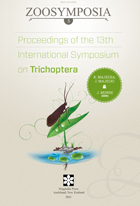Abstract
Analysis of the historical faunistic explorations in Russia demonstrates the gradual improvement of knowledge during the 20th century for this country with variable borders. Recent estimations of the Trichoptera biodiversity in the Russian Federation show the presence of 643 species in 148 genera of 28 families within its limits. The largest family, Limnephilidae, comprises 159 species, followed by Leptoceridae (92 spp.), Hydroptilidae (56), Rhyacophilidae (49), Apataniidae (41), Polycentropodidae (35), Hydropsychidae (33), Phryganeidae (28), Glossosomatidae (23), Psychomyiidae (22), Philopotamidae (19), Lepidostomatidae (18), Goeridae (12), Brachycentridae (9), Molannidae (8), Beraeidae (6), Sericostomatidae (5), Stenopsychidae (5), Arctopsychidae (4), Ptilocolepidae (4), Ecnomidae (3), Uenoidae (3), Calamoceratidae (3), and Odontoceridae (2), with Hydrobiosidae, Dipseudopsidae, Phryganopsychidae, and Thremmatidae each with a single species. The fauna of Far East Russia is the richest with 392 species, whereas European Russia in inhabited by 225 spp., the Caucasus 155, and Siberia 239. Species distribution patterns are not known in detail even in European Russia. New additions to the fauna are expected from the Far East and other regions.

